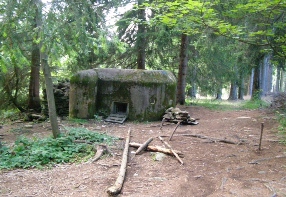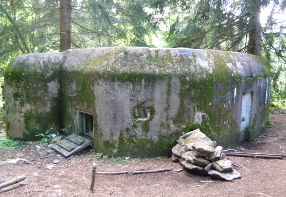Fortification system around Kubova Hu
In the connection with growing fears of 1938, steps were taken to put up a continuous line of light fortification consisting of typical small bunkers, known as řopíky. The sections of the fortification, built gradually over a period of time, connected each bunker to make a continuous line of fortification. The fortifications, which defended the strategic railway from Vimperk to Kubova Hu, were built as early as in 1937. Further section of fortification in the Kubova Hu area from Český Krumlov via Horní Vltavice and Lenora to Volary - was projected for the same year. It was to follow the banks of the Vltava up to elnava and then cross the massif of the Blanská forest to Český Krumlov. Construction of a total 598 of these bunkers was scheduled to start in 1938; however only 420 of these, including those built in 1937, had been completed by the time work ceased. The fortification line crossed some very difficult terrain and in some places access roads or temporary railway lines had to be constructed in order to transport building material. In the aftermath of the Munich Treaty, many bunkers remained unfinished; and in some places, work had not even started.
The appearance and fitting of some fortifications represented somewhat reduced versions of heavy infantry bunkers. Weapons (1-2 light or heavy machine guns) were mounted into gun carriages in the steel cast-iron embrasures, while the barred entrance with a detention door was protected by an entry embrasure. Hand-operated ventilators ensured a supply of fresh air, thus protecting a group of 5 to 7 men against suffocation due to fumes from firearms. Fortresses were also equipped with grenade slippages and one or two periscopes for monitoring the surrounding terrain. The reinforced concrete construction of the blockhouse, with a front wall and ceiling width of 80 or 12 cm (normal or strengthened), was completed with stone and earth packing built on the side facing the enemy, helping to resist the 105 mm calibre projectiles in the case of normal and 155 mm calibre in the case of strengthened construction. Individual army corps (I. - VII.) oversaw the building works under the management of the Ředitelství opevňovacích prací (Directorate of Fortification Works the abbreviation of the Czech name of this institution gave the bunkers their colloquial name řopík), which produced blueprints and approved tactical placements of the blockhouses in terrain. Construction was divided into individual sectors, including approximately 20-100 bunkers per sector, and was given to civilian companies via disclosed tenders. Yet, the most important components (embrasures, cement) were supplied directly by military command. The commander of the building works, who monitored construction, was appointed from the military unit that was to defend the given sector once work was completed.
Over time, five types of objects were built with two basic levels of resistance. With these fortifications, any terrain could be defended without the need for any atypical solutions. Each of these basic variants had sub-variants, which varied for example in the mirror-set ground-plan, height differences and various facing of the embrasures. This made construction easier and faster and, most of all, allowed the use of standardized internal equipment.
Following the declaration of mobilisation, the army moved into defensive positions, improvised covers were constructed instead of the unfinished bunkers and a network of trenches and machine gun and observation posts were dug out; these can also be viewed in the area around Kubova Hu. Three regiments were operational in the fortified area of the umava: the 1st infantry regiment from České Budějovice in the south (Blanský forest), the 11th infantry regiment from Písek in the central part (Kubova Hu) and the 35th infantry regiment in the Klatovy area. Light fortification was the backbone of the entire defence system. Bunkers (řopíky) built in 1937 were by then fully constructed and equipped at that time and contained gun carriages, doors, ventilators and periscopes (parts of these gun carriages have been preserved in some bunkers around Kubova Hu). However, most bunkers built in 1938 were in much worse condition. In some places only the concrete sections were complete, although those around Lenora and along the Vltava had already been completed and some had even been fitted out. Other bunkers were at different stages of construction and ready for improvised defence. Gun carriages were replaced by a simple hanging system with tables under embrasures, empty holes intended for periscopes were blocked and embrasures were used instead. Cartridges can still be found around some of the bunkers as evidence of the exchange of fire that took place in those intense times.
Following the signing of Munich Treaty the German army (VII. Army corps under the command of General Schobert) initiated the gradual occupation of what is now the Czech Republic. Most fortification units fell to Germans as early as 2nd October, meaning that Czech soldiers did not even have time to take equipment with them; for instance barbed-wire entanglements remained around some bunkers and surprisingly the crew of bunkers did not burn the boarding, as was common in other areas when retreating (incomplete wooden boarding can still be seen in the bunkers around Kubova Hu). Apparently even the empty bunkers made the Germans nervous and there is photographic evidence of Germans moving closer to them holding white flags. Following the occupation the Germans tested the resistance of bunkers, which is why some of them are damaged by explosives or shooting. Some 250 bunkers survived until the end of the War; one, near Lenora, was demolished by the Americans in the summer of 1945.
The appearance and fitting of some fortifications represented somewhat reduced versions of heavy infantry bunkers. Weapons (1-2 light or heavy machine guns) were mounted into gun carriages in the steel cast-iron embrasures, while the barred entrance with a detention door was protected by an entry embrasure. Hand-operated ventilators ensured a supply of fresh air, thus protecting a group of 5 to 7 men against suffocation due to fumes from firearms. Fortresses were also equipped with grenade slippages and one or two periscopes for monitoring the surrounding terrain. The reinforced concrete construction of the blockhouse, with a front wall and ceiling width of 80 or 12 cm (normal or strengthened), was completed with stone and earth packing built on the side facing the enemy, helping to resist the 105 mm calibre projectiles in the case of normal and 155 mm calibre in the case of strengthened construction. Individual army corps (I. - VII.) oversaw the building works under the management of the Ředitelství opevňovacích prací (Directorate of Fortification Works the abbreviation of the Czech name of this institution gave the bunkers their colloquial name řopík), which produced blueprints and approved tactical placements of the blockhouses in terrain. Construction was divided into individual sectors, including approximately 20-100 bunkers per sector, and was given to civilian companies via disclosed tenders. Yet, the most important components (embrasures, cement) were supplied directly by military command. The commander of the building works, who monitored construction, was appointed from the military unit that was to defend the given sector once work was completed.
Over time, five types of objects were built with two basic levels of resistance. With these fortifications, any terrain could be defended without the need for any atypical solutions. Each of these basic variants had sub-variants, which varied for example in the mirror-set ground-plan, height differences and various facing of the embrasures. This made construction easier and faster and, most of all, allowed the use of standardized internal equipment.
Following the declaration of mobilisation, the army moved into defensive positions, improvised covers were constructed instead of the unfinished bunkers and a network of trenches and machine gun and observation posts were dug out; these can also be viewed in the area around Kubova Hu. Three regiments were operational in the fortified area of the umava: the 1st infantry regiment from České Budějovice in the south (Blanský forest), the 11th infantry regiment from Písek in the central part (Kubova Hu) and the 35th infantry regiment in the Klatovy area. Light fortification was the backbone of the entire defence system. Bunkers (řopíky) built in 1937 were by then fully constructed and equipped at that time and contained gun carriages, doors, ventilators and periscopes (parts of these gun carriages have been preserved in some bunkers around Kubova Hu). However, most bunkers built in 1938 were in much worse condition. In some places only the concrete sections were complete, although those around Lenora and along the Vltava had already been completed and some had even been fitted out. Other bunkers were at different stages of construction and ready for improvised defence. Gun carriages were replaced by a simple hanging system with tables under embrasures, empty holes intended for periscopes were blocked and embrasures were used instead. Cartridges can still be found around some of the bunkers as evidence of the exchange of fire that took place in those intense times.
Following the signing of Munich Treaty the German army (VII. Army corps under the command of General Schobert) initiated the gradual occupation of what is now the Czech Republic. Most fortification units fell to Germans as early as 2nd October, meaning that Czech soldiers did not even have time to take equipment with them; for instance barbed-wire entanglements remained around some bunkers and surprisingly the crew of bunkers did not burn the boarding, as was common in other areas when retreating (incomplete wooden boarding can still be seen in the bunkers around Kubova Hu). Apparently even the empty bunkers made the Germans nervous and there is photographic evidence of Germans moving closer to them holding white flags. Following the occupation the Germans tested the resistance of bunkers, which is why some of them are damaged by explosives or shooting. Some 250 bunkers survived until the end of the War; one, near Lenora, was demolished by the Americans in the summer of 1945.


